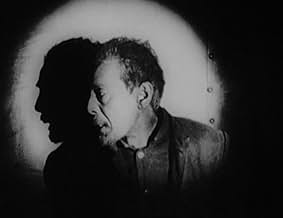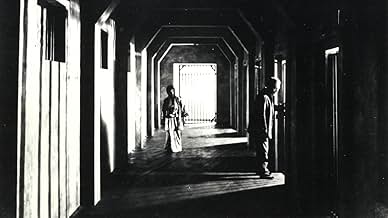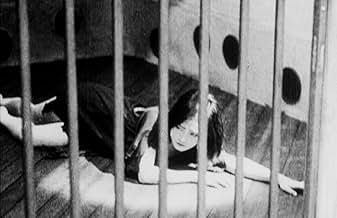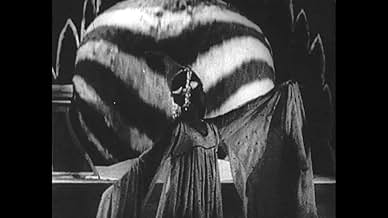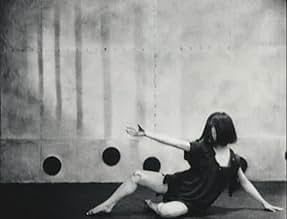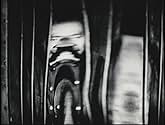VALUTAZIONE IMDb
7,3/10
5078
LA TUA VALUTAZIONE
Un uomo ottiene un lavoro in un manicomio nella speranza di vedere sua moglie.Un uomo ottiene un lavoro in un manicomio nella speranza di vedere sua moglie.Un uomo ottiene un lavoro in un manicomio nella speranza di vedere sua moglie.
- Regia
- Sceneggiatura
- Star
Recensioni in evidenza
Kurutta ippêji (1926)
*** (out of 4)
Bizarre Japanese horror film has a man taking a janitor job at an asylum so that he can be closer to his wife who was committed after trying to kill their child. Had Luis Bunuel been bore in Japan and started making movies in 1926 then I'm guessing the final product would have came out looking like this thing. Lost for decades, it's easy to see why this film was never discovered but now that it's making its way around, it seems like this is destined to become something of a cult favorite to silent and horror fans. There's no straight story being told here, instead it's more avant-garde as we get all sorts of surreal images. We get the basic story but everything else is either told in flashback or through extra fast editing that helps build up the insanity of the lead character. Director Teinosuke Kinugasa really wants to get inside the mind of the insane and I think he does a pretty good job with it. At just 59-minutes the film moves at a pretty fast rate and a lot of this can be credited to the editing. I thought that the editing was the real star of the movie as it's done in such a fashion that you often see something but then you question what it was that you actually saw. You also have to try and keep up with what's going on and everything is happening so fast that you can see that the director was trying to use this to make the viewer feel what the characters were feeling being the asylum walls. There aren't any intertitles, which just adds to the visual image and the music score (done in the 70s) fits the film very well.
*** (out of 4)
Bizarre Japanese horror film has a man taking a janitor job at an asylum so that he can be closer to his wife who was committed after trying to kill their child. Had Luis Bunuel been bore in Japan and started making movies in 1926 then I'm guessing the final product would have came out looking like this thing. Lost for decades, it's easy to see why this film was never discovered but now that it's making its way around, it seems like this is destined to become something of a cult favorite to silent and horror fans. There's no straight story being told here, instead it's more avant-garde as we get all sorts of surreal images. We get the basic story but everything else is either told in flashback or through extra fast editing that helps build up the insanity of the lead character. Director Teinosuke Kinugasa really wants to get inside the mind of the insane and I think he does a pretty good job with it. At just 59-minutes the film moves at a pretty fast rate and a lot of this can be credited to the editing. I thought that the editing was the real star of the movie as it's done in such a fashion that you often see something but then you question what it was that you actually saw. You also have to try and keep up with what's going on and everything is happening so fast that you can see that the director was trying to use this to make the viewer feel what the characters were feeling being the asylum walls. There aren't any intertitles, which just adds to the visual image and the music score (done in the 70s) fits the film very well.
A Page of Madness is an expressionistic Japanese film that has not gotten the attention it deserves. I was introduced to the film through the fifteen part documentary series The Story of Film an Odyssey. Fortunately, a friend had dubbed the silent film off of Turner Classic Movies during one of its infrequent showings.
The clip in The Story of a Film an Odyssey looked like some mad movie genius had crossed the set designs from a German expressionist film with the fast edits of a classic Russian work. This clip was from the attention grabbing opening of A Page of Madness. A janitor wanders an insane asylum at night during a storm. The storm has a strange effect on the patients and, presumably, the attendant. The edits are fast, conveying mystery and terror like in a horror film. This sequence (and a sequence at the climax) is nothing short of brilliance.
From here the film turns to a narrative, although an oblique one. This clerk or janitor seems to have an unhealthy fixation on one of the female patients. . . and more of one for this patient's daughter. The janitor clearly knew this family before the mother was committed. IMDb says that the woman is the janitor's wife. I am not doubting this, but the film is not clear on this point. What is clear is that the janitor is suffering from a lack of love. This janitor is not the only one. One patient is compelled to dance suggestively and nearly starts a riot. By contrast, the doctors appear clinical and ineffectual. As the film goes along, the protagonist's mental state seems to wane.
Much about the plot is unclear. Many Japanese silent were narrated by a spokesman in the theater. This may have been the case with A Page of Madness; thus, some of the ambiguity would have been explained by the live narrator. I prefer to think the ambiguity was deliberate and never explained. The film has a wonderful sense of mystery to it. I don't want any more of an explanation. I (and probably most film fans) watch a lot of movies that are merely fair. These films are watchable, but they do not stay in one's memory. That is why A Page of Madness is so stunning. It kicks the door down and announces itself to the world. I feel less like a reviewer than a herald for a lost classic. Are you listening Criterion?
The clip in The Story of a Film an Odyssey looked like some mad movie genius had crossed the set designs from a German expressionist film with the fast edits of a classic Russian work. This clip was from the attention grabbing opening of A Page of Madness. A janitor wanders an insane asylum at night during a storm. The storm has a strange effect on the patients and, presumably, the attendant. The edits are fast, conveying mystery and terror like in a horror film. This sequence (and a sequence at the climax) is nothing short of brilliance.
From here the film turns to a narrative, although an oblique one. This clerk or janitor seems to have an unhealthy fixation on one of the female patients. . . and more of one for this patient's daughter. The janitor clearly knew this family before the mother was committed. IMDb says that the woman is the janitor's wife. I am not doubting this, but the film is not clear on this point. What is clear is that the janitor is suffering from a lack of love. This janitor is not the only one. One patient is compelled to dance suggestively and nearly starts a riot. By contrast, the doctors appear clinical and ineffectual. As the film goes along, the protagonist's mental state seems to wane.
Much about the plot is unclear. Many Japanese silent were narrated by a spokesman in the theater. This may have been the case with A Page of Madness; thus, some of the ambiguity would have been explained by the live narrator. I prefer to think the ambiguity was deliberate and never explained. The film has a wonderful sense of mystery to it. I don't want any more of an explanation. I (and probably most film fans) watch a lot of movies that are merely fair. These films are watchable, but they do not stay in one's memory. That is why A Page of Madness is so stunning. It kicks the door down and announces itself to the world. I feel less like a reviewer than a herald for a lost classic. Are you listening Criterion?
I saw the 1 hour version shown on TCM. I'll like to see the 78 minute restoration as this version has no inter titles, no translation of signs and missing a third of the film. Now, back then a benshi would live narrate so there wouldn't be titles but do they have a copy of what the benshi said during the film (if anything)? I would read a synopsis before watching as it makes things clearer. The plot is hard to follow, some of it is from the POV of crazy people or the dream of the protagonist. Well worth watching but more for admiration than enjoyment.
Kurutta Ippeji offers a view on the distorted perspective of a troubled janitor in a mental asylum. As a proof of concept, it shows that experimental cinematic techniques can affect the way narration is perceived by the viewer - here, the visual elements contribute to how the viewer experiences the characters' mental state. As an experiment, the movie possibly even makes a stronger case than the comparably surreal Hausu (1977), which is partly imbalanced in its style. However, due to the poor visual quality and the lack of functional storytelling, this experimental feature can't be easily recommended to people looking for a more conventional feature.
Overall 7/10
Full Review on movie-discouse.blogspot.com
If you do not think you can take graphic scenes of mentally unstable people, this film is not for you.This story is about a man who takes a job at a local mental institution so he can be near his wife, who has gone mad. Throughout this long thought lost film you see clearly harrowing images of people at the institution. The soundtrack only adds to the foreboding. There are people lying catatonic and there is a dancer who doesn't stop dancing until she drops to the floor, exhausted. The film is 59 minutes long, I think it was originally longer but this was all that was found. There are no inter titles, its a silent film. In Japan, I am certain the benshi narrated the story in theaters, but your imagination has to follow this story. So, why a 7? It is daring, unflinching, brave and both ugly and not at the same time. As a point of reference only, Guy Maddin's work approaches this. Just know going in there is no happiness here. You won't soon forget this film. Best idea: Don't watch it before bedtime, it will stay with you.
Lo sapevi?
- QuizThis film was deemed lost for more than forty years, but it was rediscovered by its director, Teinosuke Kinugasa, in a rice cans in 1971.
- Versioni alternativeReissued in Japan in 1973 with musical score replacing original benshi.
- ConnessioniFeatured in Storia del cinema: Un'odissea: The Golden Age of World Cinema (2011)
I più visti
Accedi per valutare e creare un elenco di titoli salvati per ottenere consigli personalizzati
- How long is A Page of Madness?Powered by Alexa
Dettagli
- Data di uscita
- Paese di origine
- Lingue
- Celebre anche come
- Una pagina folle
- Luoghi delle riprese
- Kyoto, Giappone(Studio)
- Aziende produttrici
- Vedi altri crediti dell’azienda su IMDbPro
Botteghino
- Budget
- 20.000 JPY (previsto)
- Tempo di esecuzione
- 1h 10min(70 min)
- Colore
- Mix di suoni
- Proporzioni
- 1.33 : 1
Contribuisci a questa pagina
Suggerisci una modifica o aggiungi i contenuti mancanti

